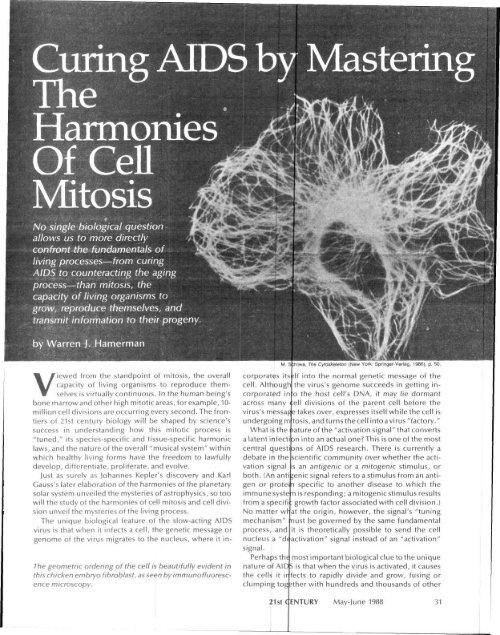The Geometry The Nucleus
The Geometry The Nucleus
The Geometry The Nucleus
You also want an ePaper? Increase the reach of your titles
YUMPU automatically turns print PDFs into web optimized ePapers that Google loves.
Curing AIDS by Mastering<br />
<strong>The</strong><br />
Harmonies<br />
Of Cell<br />
Mitosis<br />
No single biological question<br />
allows us to more directly<br />
confront the fundamentals of<br />
living processes—from curing<br />
AIDS to counteracting the aging<br />
process—than mitosis, the<br />
capacity of living organisms to<br />
grow, reproduce themselves, and<br />
transmit information to their progeny.<br />
by Warren J. Hamerman<br />
M. S :hliwa, <strong>The</strong> Cytoskeleton (New York: Springer-Verlag, 1986), p. 50.<br />
Viewed from the standpoint of mitosis, the overall<br />
capacity of living organisms to reproduce themselves<br />
is virtually continuous. In the human being's<br />
bone marrow and other high mitotic areas, for example, 10-<br />
million cell divisions are occurring every second. <strong>The</strong> frontiers<br />
of 21st century biology will be shaped by science's<br />
success in understanding how this mitotic process is<br />
"tuned," its species-specific and tissue-specific harmonic<br />
laws, and the nature of the overall "musical system" within<br />
which healthy living forms have the freedom to lawfully<br />
develop, differentiate, proliferate, and evolve.<br />
Just as surely as Johannes Kepler's discovery and Karl<br />
Gauss's later elaboration of the harmonies of the planetary<br />
solar system unveiled the mysteries of astrophysics, so too<br />
will the study of the harmonies of cell mitosis and cell division<br />
unveil the mysteries of the living process.<br />
<strong>The</strong> unique biological feature of the slow-acting AIDS<br />
virus is that when it infects a cell, the genetic message or<br />
genome of the virus migrates to the nucleus, where it in-<br />
<strong>The</strong> geometric ordering of the cell is beautifully evident in<br />
this chicken embryo fibroblast, as seen by immunofluorescence<br />
microscopy.<br />
corporates its :lf into the normal genetic message of the<br />
cell. Although the virus's genome succeeds in getting incorporated<br />
in o the host cell's DNA, it may lie dormant<br />
across many iiell divisions of the parent cell before the<br />
virus's messag e takes over, expresses itself while the cell is<br />
undergoing m tosis, and turns the cell into a virus "factory."<br />
What is the lature of the "activation signal" that converts<br />
a latent inf ecti Dn into an actual one? This is one of the most<br />
central questiDns of AIDS research. <strong>The</strong>re is currently a<br />
debate in the scientific community over whether the activation<br />
signal s an antigenic or a mitogenic stimulus, or<br />
both. (An anti »enic signal refers to a stimulus from an antigen<br />
or protei T specific to another disease to which the<br />
immune syste n is responding; a mitogenic stimulus results<br />
from a specifi : growth factor associated with cell division.)<br />
No matter wr at the origin, however, the signal's "tuning<br />
mechanism nust be governed by the same fundamental<br />
process, and it is theoretically possible to send the cell<br />
nucleus a "deactivation" signal instead of an "activation"<br />
signal<br />
Perhaps thd most important biological clue to the unique<br />
nature of AIDS is that when the virus is activated, it causes<br />
the cells it irfects to rapidly divide and grow, fusing or<br />
clumping tog ;ther with hundreds and thousands of other<br />
21st(ENTURY May-June 1988 31

















